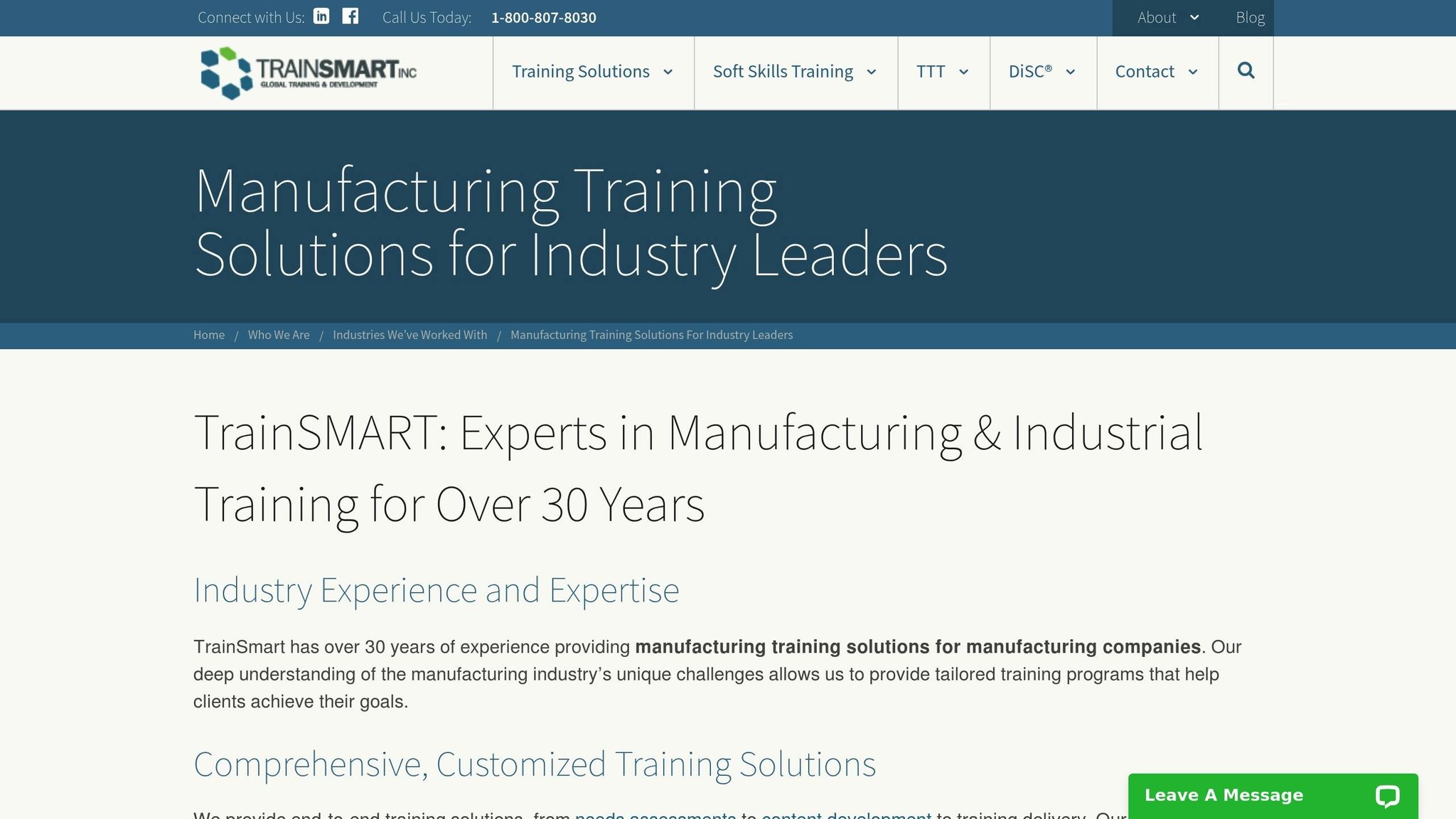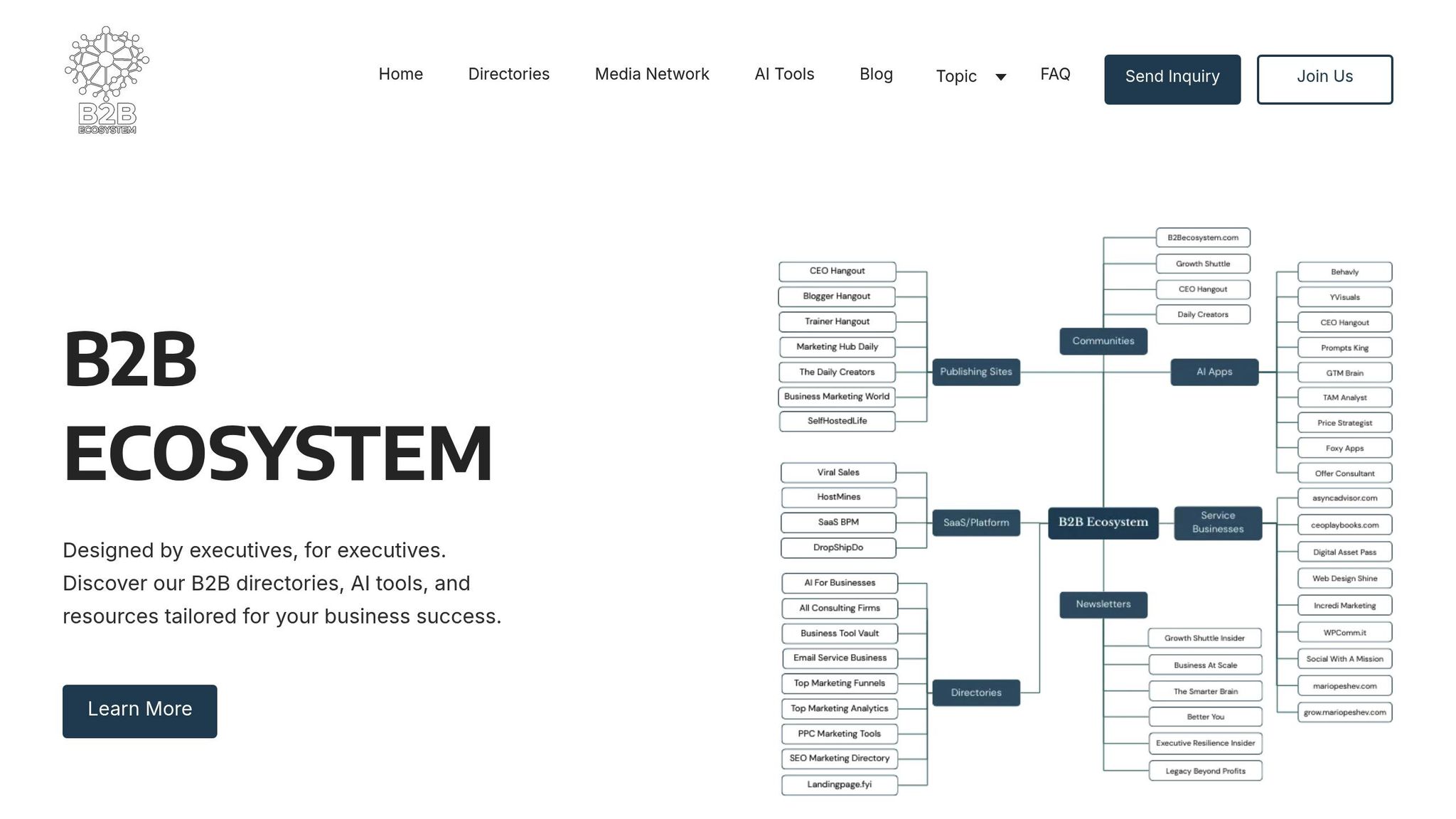Upskilling your workforce isn’t optional anymore - it’s a necessity. With 87% of global companies facing skill gaps and 74% of U.S. employers struggling to find skilled talent, businesses are losing productivity and profitability. For example, organizations lose an average of 25 workdays annually due to insufficient skills, and by 2024, 32% of job skills will have changed compared to 2021.
The solution? Custom training programs that address specific skill gaps, align with business goals, and deliver measurable outcomes like higher productivity, lower turnover, and better financial performance. Unlike generic training, tailored solutions focus on your organization’s unique needs, ensuring employees gain the exact skills required to excel in their roles.
Here’s what you’ll learn:
- Why identifying skill gaps is critical and how to do it effectively.
- How personalized and modular training delivers better results.
- Why custom training outperforms generic programs in ROI and relevance.
- How AI tools are revolutionizing training strategies.
Key takeaway: Investing in tailored training isn’t just about upskilling - it’s about staying competitive in a fast-changing business landscape.
Manufacturing Training Solutions | Custom Workforce Development by TrainSMART

Finding Skills Gaps: The Foundation of Effective Training
To create effective training programs, it’s essential to start by identifying the skills your employees currently possess and comparing them to the skills your business needs. This process, known as skills gap analysis, helps pinpoint the areas where training is needed most. Without this clarity, even the most well-meaning training efforts can fall short of expectations.
This challenge is becoming increasingly urgent. Rapid changes in required skills and ongoing talent shortages make it critical to adopt a precise training strategy. When done right, targeted training leads to measurable results.
Uncovering skills gaps provides several key advantages:
| Benefit | Description |
|---|---|
| Targeted Training | Focused training addresses specific deficiencies, improving skill development on the job. |
| Boosted Productivity | Employees equipped with the right skills work more efficiently and confidently, driving better performance. |
| Competitive Edge | Companies that close skill gaps quickly adapt to industry changes and new technologies faster. |
| Employee Engagement and Retention | Investing in development shows employees they’re valued, which increases job satisfaction and loyalty. |
| Strategic Alignment | Matching employee skills with company goals ensures everyone is working toward the same objectives. |
How to Conduct a Skills Gap Analysis
A thorough skills gap analysis combines various data sources to get a complete understanding of where your workforce stands. Start by identifying the skills your company needs to meet its goals, then evaluate how your employees measure up.
Employee surveys and self-assessments are good starting points. These can be complemented by manager evaluations, performance reviews, and objective skills tests.
Many organizations now use AI and data analytics to make this process faster and more accurate. These tools analyze large amounts of workforce data, track industry trends, and even recommend personalized learning paths. For instance:
- Pearson assessed 2,000 employees using AWS tools.
- NHS trusts used surveys and direct observations to evaluate digital skills.
- NASA created a talent-mapping database to align employee skills with project requirements.
Importantly, skills gap analysis shouldn’t be a one-time task. It works best as an ongoing process integrated into regular performance reviews. By using self-service tools, employees can take ownership of their growth. As Miriam Groom, CEO of Mindful Career and Leader Human Capital at KPMG, puts it:
"Skills gap analysis in the modern age isn't just about identifying missing competencies but also about creating an organizational culture of continuous learning, adaptation, and collaboration."
Matching Training Needs with Business Goals
Once you’ve identified the gaps, the next step is to align training efforts with your company’s strategic objectives.
Training programs tied to clear business goals are significantly more effective. Start by defining measurable outcomes - whether that’s boosting revenue, improving customer satisfaction, or increasing operational efficiency. Data analytics can play a big role here, with high-performing companies being three times more likely to use analytics to track the impact of their learning programs.
Take HCSS, a construction software company, as an example. They refined their training approach by focusing on the question, "How do we prove the impact of our learning programs on our customers?" Using the Kirkpatrick Model, they collected customer feedback through NPS surveys and course ratings in their LMS (Docebo). By analyzing data from both their LMS and customer management software, they discovered that trained customers used software features more often. This allowed them to improve their software design and create personalized learning paths that directly supported customer success.
Similarly, Pernod Ricard embraced a company-wide shift to a skills-based framework to tackle talent management challenges. By utilizing Lightcast Skills data and integrating Talent Transform, they revamped job descriptions, improved recruitment, and enhanced training and upskilling efforts. This approach also enabled them to monitor skill usage, attrition, and emerging trends proactively.
The most successful organizations set SMART (specific, measurable, achievable, relevant, and time-bound) goals, linking individual development to broader company strategies. They also establish regular feedback loops to refine and improve training programs. With 63% of companies predicting that skills gaps will remain a major obstacle to transformation through 2030, those who align training with business strategy will not only overcome this challenge but use it as a springboard to stay ahead of the competition.
Key Features of Custom Training Modules
Custom training modules are designed to bridge workforce skill gaps by addressing the unique challenges your company faces. Unlike generic, one-size-fits-all programs, these tailored solutions focus on specific needs, delivering better retention, performance, and engagement.
The impact of custom training is evident in real-world outcomes. For instance, a multinational manufacturing company introduced customized training for their sales and supply chain teams. The results? A 30% boost in overall sales performance for frontline sales executives and a 25% drop in supply chain compliance issues. These outcomes highlight how targeted training not only meets workforce needs but also drives business success, offering a higher return on investment compared to standard training options.
What makes these programs so effective? They are crafted to address your organization’s specific challenges, align with industry demands, and close skill gaps in your workforce.
Modular and On-Demand Learning
Custom training modules often feature a modular design, breaking down complex topics into manageable sections. This approach acknowledges the need for today’s employees to balance learning with their day-to-day responsibilities.
Modular learning works because it adapts to different learning styles and schedules. Employees can focus on the skills they need without wasting time on irrelevant material. For example, a sales representative could quickly access a module on negotiation techniques before a client meeting, while a supply chain manager might review compliance protocols ahead of a regulatory audit.
This flexibility is especially valuable in today’s fast-changing work environment. As McKinsey points out:
"The rapid rise of digitization and remote work has placed new demands on employees who, in many instances, now require different skills to support significant changes to how work gets done and to the business priorities their companies are setting."
The modular setup also allows for scalability. Companies can expand their training programs by adding new modules as technologies evolve or business needs shift. This adaptability is vital, considering that 69% of organizations are focusing more on skill-building now compared to pre-COVID-19 levels.
While modular training ensures effective content delivery, personalization takes it a step further by tailoring the learning experience to each individual.
Personalized Learning and Real-Time Feedback
Personalized learning paths are a cornerstone of custom training, aligning content with an employee’s specific needs, career goals, and existing skill levels. This tailored approach not only makes learning more engaging but also more effective.
For example, AI-driven personalization can increase employee engagement by up to 60%. As Josh Bersin, a leading HR expert, states:
"AI is not just an enhancement to training programs - it is the future of workforce development."
Real-time feedback plays a critical role in this personalized approach. It allows employees to continuously refine their skills, creating a cycle of ongoing improvement. Research shows that learners who receive individualized feedback are 50% more likely to retain information.
Here’s how different types of feedback impact learners:
| Type of Feedback | Impact on Learners | Statistics |
|---|---|---|
| Instant Feedback | Increased engagement | 70% of students |
| Specific Suggestions | Improved performance on assessments | 68% improvement rate |
| Peer Responses | Enhanced critical thinking | 54% participation boost |
| Instructor Comments | Better knowledge retention | 75% of learners |
Additionally, adaptive assessments dynamically adjust to match a learner’s performance. This ensures employees are appropriately challenged without feeling overwhelmed, leading to better outcomes. For example, tailored evaluations can improve knowledge retention by 30% and boost test scores by up to 20%.
Personalized learning also empowers employees by giving them control and ownership over their development, which fosters greater commitment. This is particularly important given that 62% of workers would consider switching jobs for better skill advancement opportunities.
When combined, modular design and personalized learning create a training ecosystem that delivers meaningful results. Employees receiving specific feedback are 56% more likely to complete courses, and 90% of learners prefer tailored advice over generic suggestions. By aligning training with individual goals and addressing precise skill gaps, custom training becomes a strategic advantage for both employees and businesses.
These features set the stage for a comparison between tailored training solutions and generic methods, highlighting the clear benefits of a customized approach.
sbb-itb-01010c0
Custom vs. Generic Training Solutions: A Comparison
When it comes to addressing skills gaps and creating effective learning programs, the choice between custom and generic training solutions can have a profound impact on workforce development. While off-the-shelf courses may seem appealing due to their lower upfront costs, the long-term benefits of custom training often outweigh the initial investment.
Generic training takes a one-size-fits-all approach, which rarely aligns with the unique needs of your organization. These programs typically offer basic, standardized information that may not fully prepare employees for the specific challenges of their roles. Even worse, without reinforcement, employees forget 70% of the information within 24 hours. This lack of alignment can result in wasted time and reduced productivity.
On the other hand, custom training is designed to address your company’s unique challenges and operational requirements. As Stephan Härle, an Instructional Designer at imc, puts it:
"Custom really means customised for a specific requirement and tailored to the learners' needs."
Take the example of ABC Solutions, a SaaS company with over 500 employees. Initially, they implemented off-the-shelf CRM training for a new platform. However, they soon realized the generic course didn’t address their specific CRM configuration or internal processes. After switching to a custom training solution, they saw an 18% increase in sales productivity, a 60% drop in CRM-related support tickets, and a 10% improvement in lead conversion rates, thanks to tailored modules that focused on their unique lead scoring system.
While generic training may save money upfront, it often falls short in delivering long-term value. Employees may need to sift through multiple courses to find relevant information, leading to inefficiencies. Custom training, by contrast, delivers a higher return on investment by focusing on the skills and knowledge that matter most to your organization. This targeted approach supports sustainable growth and scalability.
The financial implications are clear. Research shows that ineffective training costs businesses an average of $13.5 million per year for every 1,000 employees. Furthermore, 50% of employees who don’t receive effective training leave their positions within the first year, with the average cost of hiring and onboarding a replacement reaching about $4,000.
Comparison Table: Key Benefits of Custom Training
| Feature | Custom Training | Generic Training |
|---|---|---|
| Content Relevance | Tailored to organizational needs and industry specifics | Standardized content, often lacking relevance |
| Employee Engagement | 60% higher retention rates with personalized paths | Limited engagement due to lack of context |
| Performance Impact | 30% greater competency improvements | Moderate improvements with general skill development |
| Cost Structure | Higher upfront cost ($25,000–$80,000), better long-term ROI | Lower initial cost ($5–$50 per user monthly), higher ongoing expenses |
| Deployment Speed | Longer development time, aligned to goals | Quick deployment with ready-made content |
| Scalability | Adaptable to evolving needs | Limited, often requires additional purchases |
| Content Control | Full ownership and immediate updates | Limited control, dependent on provider updates |
| Competitive Advantage | Incorporates proprietary knowledge and best practices | Generic content accessible to competitors |
Custom training doesn’t just improve engagement - it transforms it. Studies show that customized learning leads to 42% higher engagement rates compared to generic formats. This heightened engagement translates into tangible results, with companies reporting a 17% increase in productivity and a 21% boost in profitability when employees receive targeted training.
For industries with specialized needs, generic solutions often fall short. For instance, a construction company working on archaeological sites required training on preservation protocols - something no off-the-shelf course could address. Similarly, a healthcare provider collaborated with CAPE to develop training tailored to their patient management systems, which significantly improved patient care and operational efficiency.
Custom training also offers unmatched flexibility. Unlike generic courses, which are tied to the provider’s update schedule, custom solutions can be updated immediately to reflect changes in business needs. This adaptability ensures your training remains relevant in today’s fast-paced environment, where 93% of high-performing organizations agree that personalized learning helps employees achieve their goals more effectively.
While generic training has its place - especially for foundational skills or compliance requirements - it’s clear that custom solutions deliver superior results when your goal is strategic workforce development. Tailored training not only boosts engagement and productivity but also drives real business outcomes, ensuring your organization stays competitive in a rapidly changing world.
Implementing Custom Training with The B2B Ecosystem

To make the most of custom training, you need more than just good intentions - you need a well-constructed system that combines expertise, tools, and partnerships. That’s where The B2B Ecosystem steps in. It offers a unified platform that simplifies workforce upskilling, covering everything from program design to optimization.
This approach integrates AI-driven tools, expert consulting services, and B2B directories, giving businesses the resources they need to create training programs that deliver real results. Instead of juggling solutions from multiple vendors, you get a cohesive ecosystem tailored for B2B growth and operational success.
Designing Tailored Training Solutions
A strong custom training program starts with a clear understanding of your industry’s challenges and your company’s goals. The B2B Ecosystem’s directories are a great resource for connecting with consulting firms that specialize in workforce planning and training.
Through these directories, businesses can find workforce planning consultants who align talent strategies with long-term objectives. This is especially important as the job market shifts toward skills-based hiring. For example, Pennsylvania recently removed four-year degree requirements for 65,000 jobs, signaling a move toward prioritizing skills over degrees. Similar initiatives in Maryland and Utah further highlight this trend.
But The B2B Ecosystem doesn’t stop at connecting you with consultants. It offers strategic advisory services to help businesses pinpoint the best training approaches for their needs. Whether you’re focusing on cross-functional skills, role-specific training, or leadership development, the ecosystem provides the guidance to get it right.
For companies aiming to scale their training efforts, the platform also connects you with experts in program scalability and change management. This ensures your training programs can grow alongside your business while staying effective across various teams and locations.
Once your tailored training strategies are in place, the next step is to take advantage of AI tools to maximize their impact.
Using AI Tools for Training Optimization
Incorporating artificial intelligence into training programs isn’t just a nice-to-have - it’s quickly becoming essential. A recent survey found that 66% of leaders wouldn’t hire someone without AI skills, and 71% would prefer a less experienced candidate with AI skills over a more experienced one without them. The B2B Ecosystem’s AI tools are designed to help businesses address this shift by optimizing both training delivery and employees’ AI proficiency.
One standout tool is the AI Process Optimizer, which can transform how training programs are designed and executed. By analyzing workflows and identifying inefficiencies, this tool helps streamline training processes. The results speak for themselves: AI power users save more than 30 minutes a day, with 90% saying AI helps them save time and 85% reporting that it allows them to focus on more critical tasks.
Another key feature is real-time analytics and progress tracking, which allows businesses to monitor training effectiveness, measure impact, and identify skill gaps before they become major challenges. This proactive approach ensures training stays relevant as business needs evolve.
The benefits of AI-enhanced training are already evident in leading organizations. For example:
- KPMG has seen a 50% increase in employee productivity.
- Dentsu is saving hundreds of employees up to 30 minutes daily on creative tasks.
- EY uses AI to generate reports and access insights almost instantly.
AI also enables personalized learning paths tailored to each employee’s role, skill level, and learning preferences. This level of customization ensures that employees get training that’s not only relevant but also highly effective.
Additionally, automation features reduce the administrative burden on learning and development teams. Tasks like onboarding, skill assessments, and course assignments can be automated, freeing up teams to focus on strategic priorities.
As Jason Alhoff, Microsoft’s Chief Commercial Officer, puts it:
"AI will disrupt and transform partner business models across the dimensions of their engagement with software vendor partners. Understanding and responding to this will allow SaaS vendors to drive convergence by pulling the ecosystems' needs into their AI strategy."
AI tools also provide immediate feedback and coaching, creating a real-time feedback loop that boosts knowledge retention and skill development. This addresses the common issue of employees forgetting training content without proper reinforcement.
Conclusion: The Path to Workforce Excellence
Custom training, from identifying skill gaps to leveraging AI for tailored delivery, has proven to be a game-changer in workforce development. It’s not just about improving skills - it’s about driving tangible business outcomes. For example, organizations that align training with real-world scenarios see a 55% boost in employee retention. On top of that, personalized learning experiences can enhance knowledge retention by up to 60%. These benefits create a ripple effect, paving the way for sustained financial and operational success.
On the flip side, ineffective training comes at a steep cost - an average of $13.5 million per year for every 1,000 employees. Even more concerning, 50% of employees who don’t receive proper training leave their roles within the first year. Clearly, investing in targeted and effective training isn’t just a choice; it’s a necessity for any organization aiming for long-term growth.
This is where The B2B Ecosystem steps in. By integrating advanced tools and expert guidance, it offers a comprehensive approach to workforce development that transcends traditional training methods. The platform addresses seven critical areas of workforce strategy: workforce planning, talent acquisition, performance management, compensation and rewards, learning and development, career paths, and organization design. This holistic approach ensures that businesses are not just reacting to change but are prepared to thrive in it.
What makes The B2B Ecosystem stand out? Its ability to adapt to unpredictable hiring trends and rapidly shifting skill demands. By combining AI-powered tools like the AI Process Optimizer with expert consulting and B2B directories, it delivers a unified solution that tackles both immediate training needs and broader workforce strategies. The platform also empowers organizations to rethink their structure, enabling them to operate more efficiently around teams, projects, and networks. This includes streamlining communication, clarifying decision-making processes, and enhancing reporting systems.
"Custom eLearning is a strategic investment for businesses looking to upskill and reskill their workforce. By addressing the unique needs of the employees, custom eLearning solutions help organizations in upskilling and reskilling their employees and attaining maximum ROI. It does so by delivering relevant, engaging, and efficient training that drives performance and supports long-term success." - CommLab India
The takeaway is clear: investing in flexible, targeted e-learning solutions is essential to meet the demand for new skills while avoiding losses in ROI, productivity, and employee morale. This requires a strategic approach - identifying skill gaps, mapping them to business goals, and creating custom learning programs supported by the right tools.
With The B2B Ecosystem, this vision becomes a reality. Its scalable platform equips organizations to meet today’s challenges while staying prepared for tomorrow. This is the essence of workforce excellence - building a team that’s not only skilled but ready to adapt and succeed in an ever-changing business world.
FAQs
How do custom training modules boost productivity and employee engagement more effectively than generic programs?
Custom training programs can boost both productivity and employee engagement by catering to the specific needs of your team. By zeroing in on skills that directly align with your business goals and the roles of your employees, these programs allow individuals to immediately put their new knowledge to use. The result? Greater efficiency and improved job satisfaction.
These tailored programs also take into account varying learning styles and the unique challenges your organization might face. This makes the training experience more engaging and relevant. Plus, showing employees that you’re invested in their development doesn’t just enhance their performance - it can also build loyalty and improve retention.
What are the main steps to identify skill gaps and implement effective custom training programs?
To address skill gaps and design impactful training programs, begin by clarifying your organization's goals and identifying the specific skills needed to meet them. Then, assess your team's current abilities using tools like surveys, performance evaluations, or skill assessments. This comparison will help you spot the gaps between where your workforce is now and where they need to be. With these gaps in mind, create a customized training plan that aligns with your company's objectives. Remember, this process should be continuous, allowing you to adapt as your workforce and industry demands change.
How can AI tools improve the effectiveness of custom workforce training programs?
AI tools are transforming workforce training by creating personalized learning experiences that adapt to each employee's unique needs. They offer real-time feedback, allowing employees to monitor their progress and fine-tune their learning paths, which helps improve both engagement and knowledge retention.
On top of that, AI analyzes performance data to uncover skill gaps and suggest specific content to address them. This targeted approach makes training more effective, enhances employee performance, and ensures that training efforts align seamlessly with the goals of the organization.


